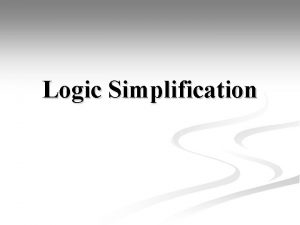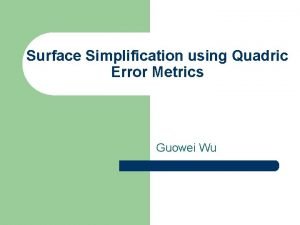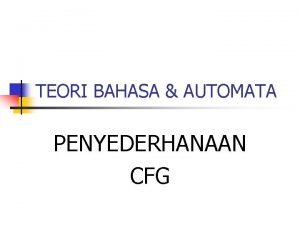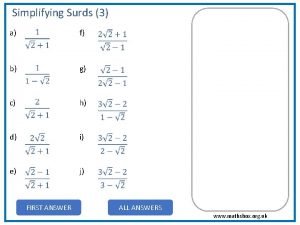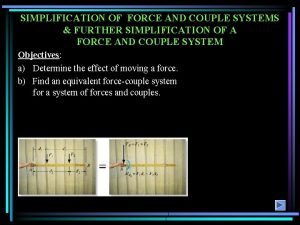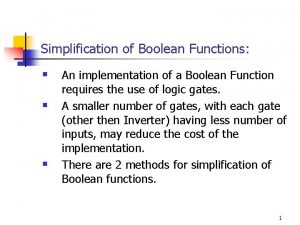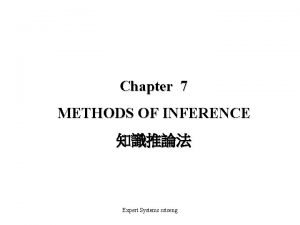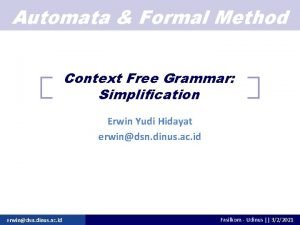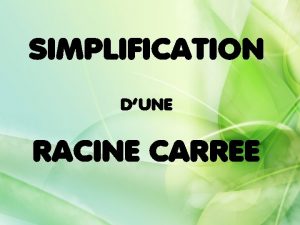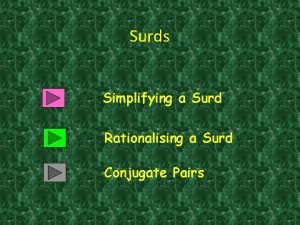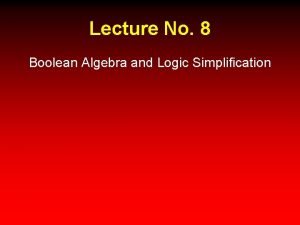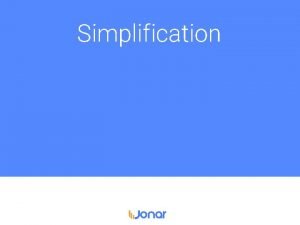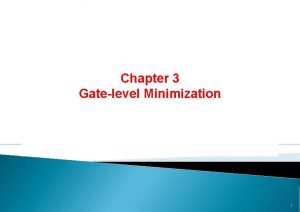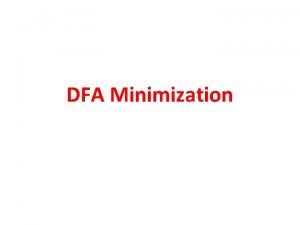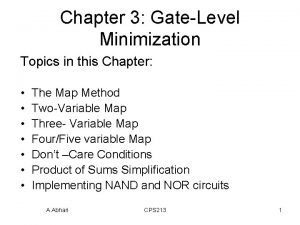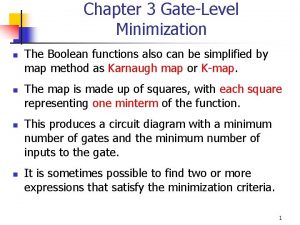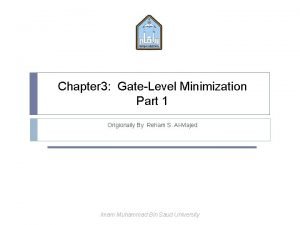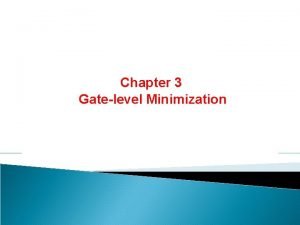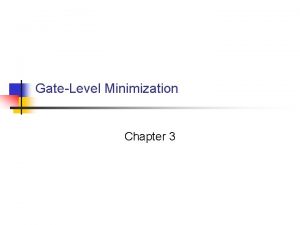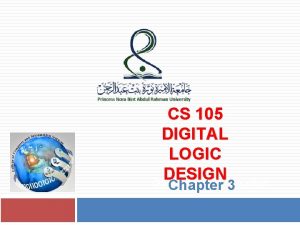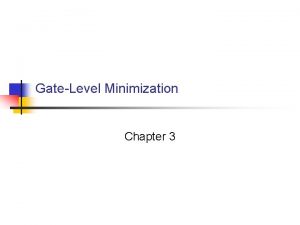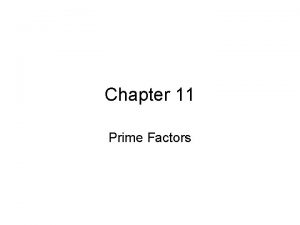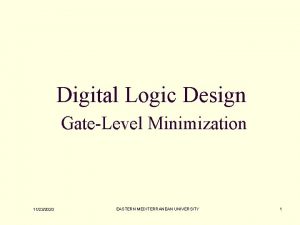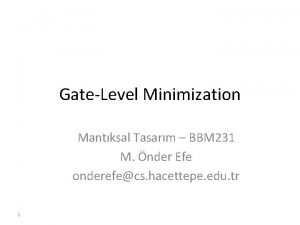Chapter 3 Gatelevel Minimization 1 Simplification Using Prime
















- Slides: 16

Chapter 3 Gate-level Minimization 1

Simplification Using Prime Implicants § A Prime Implicant is a product term obtained by combining the maximum possible number of adjacent squares in the map into a rectangle with the number of squares a power of 2. § A prime implicant is called an Essential Prime Implicant if it is the only prime implicant that covers (includes) one or more minterms. § Prime Implicants and Essential Prime Implicants can be determined by inspection of a K-Map. 2

1 3

Example of Prime Implicants Find ALL Prime Implicants CD C BD 1 1 BD A AB 1 1 1 1 D AD ESSENTIAL Prime Implicants C BD 1 1 1 BD 1 B A 1 1 1 1 D BC Minterms covered by single prime implicant

Prime Implicant Practice Find all prime implicants for: F (W, X, Y, Z) = (0, 2, 3, 8, 9, 10, 11, 12, 13, 14, 15) Y 1 1 W 1 1 1 1 1 X Z Prime implicants are: W, X‘Y, and X‘Z‘ Note that all of these prime implicants are essential.

Another Example Find all prime implicants for: G(W, X, Y, Z) = (0, 2, 3, 4, 7, 12, 13, 14, 15) ◦ Hint: There are seven prime implicants! Y 1 1 1 1 1 X W Z Prime Implicants are WX, XY’Z', W’X’Z', W’X’Y, W’YZ, XYZ. There is only one essential prime implicant: WX.

3 -4 Five-Variable Map 7

8

Example 3 -7 9

3 -5 Product-of-Sums Simplification E. g. Simplify the following Boolean function in product-of -sums form F(A, B, C, D)= m(0, 1, 2, 5, 8, 9, 10) 1. 2. 3. 4. Mark with 1’s the minterms of F. Mark the remaining squares with 0’s. These represent F’. Find the simplified F’. F’ = AB + CD + BD’ Complement 3 to obtain a simplified F in product-ofsums form F = (A’ + B’)(C’ + D’) (B’ +D)

Product-of-Sums Simplification Simplify : F= (0, 1, 2, 5, 8, 9, 10) in Product-of-Sums Form 1. Mark with 0’s the Maxterms of F 2. Combine 0’s to obtain a simplified F’ in SOP. A 3. Complement 2 to obtain a simplified F in POS. F’ = AB + CD + BD’ F = (A’+B’)(C’+D’)(B’+D) C B D

Example 3 -8 Simply Boolean function F(A, B, C, D) = (0, 1, 2, 5, 8, 9, 10) in (a) sum of products and (b) product of sums (a) F = B’D’ + B’C‘ + A’C’D (b) 1. Obtain simplified complemented function: F’ = AB + CD+BD’ 2. Applying De. Morgan’s theorem to obtain F F = (A’ + B’) (C’+D’) (B’ + D) 12

Gate Implementation for Example 3 -8 13


3. 6 Don't Cares Condition Sometimes a function table or map contains entries for which it is known: ◦ the input values for the minterm will never occur, or ◦ The output value for the minterm is not used In these cases, the output value need not be defined Instead, the output value is defined as a “don't care” By placing “don't cares” ( an “x” entry) in the function table or map, the cost of the logic circuit may be lowered. Example 1: A logic function having the binary codes for the BCD digits as its inputs. Only the codes for 0 through 9 are used. The six codes, 1010 through 1111 never occur, so the output

Example 3 -9 product of sums? 16
 Logic simplification
Logic simplification Surface simplification using quadric error metrics
Surface simplification using quadric error metrics Jeff bezos prime video prime
Jeff bezos prime video prime Bahasa automata
Bahasa automata Surds simplification
Surds simplification Couple system
Couple system Simplification of boolean functions
Simplification of boolean functions Pinpointing the enemy propaganda
Pinpointing the enemy propaganda Examples of bandwagon
Examples of bandwagon Articulatory simplification
Articulatory simplification Wintr20
Wintr20 Consensus theorem in digital electronics
Consensus theorem in digital electronics How to simplify context free grammar
How to simplify context free grammar Racine de 8 simplification
Racine de 8 simplification Rationalise a surd
Rationalise a surd Asdw simplification
Asdw simplification Boolean algebra and logic simplification
Boolean algebra and logic simplification
